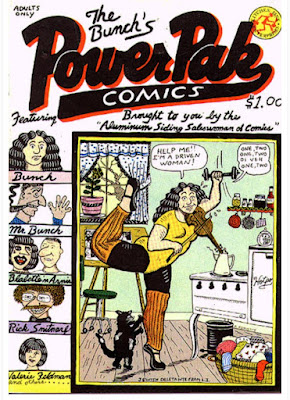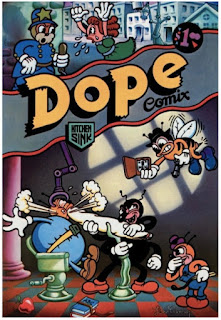Cover: Dennis Fujitake
Back cover: Bob Aull
THE COMICS JOURNAL 49 (September 1979)
Executive Editor: Gary Groth
Editor/Circulation Director: Kim Thompson
Consulting Editor: J. Michael Catron
Assistant Editor: Bob Soron
Correspondent [UK]: John Dakin
Correspondent [Comix]: Bruce Sweeney
Mascots: Leif Allmendiger; Eric Bethke-Coehn; Sheila Mooney; Heidi Pygman; Janet Toombs; Jan Trendowski; and, "Little" Gretchen Meyer
Janet Toombs, a few years later
Source
Distributors: Seagate Distributors (Brooklyn, NY); Bud Plant (Grass Valley, CA); Big Rapids Distributors (Detroit, MI); New Media (Rockville, MD); Well News Service (Columbus, OH).
1. NEWSWATCH: Undergrounds
These are the comix listed as new, coming soon, or in the works as some of them didn't turn up until 1981. Links to a number of items still available from Last Gasp, Rip Off Press, or Denis Kitchen.
Last Gasp
GCD
Last Gasp
GCD
Last Gasp
GCD
GCD
GCD
GCD
GCD
Last Gasp
GCD
Last Gasp
GCD
GCD
Last Gasp
Denis Kitchen
2. NEWSWATCH: Whitman Comics (Dynabrite albums were, I believe, forerunners of the explosion of Baxter paper reprints from Marvel and DC in the 80s. Great idea from Whitman (king of the comics three-pack), just the wrong time.)
GCD
3. COMICS REVIEWS: Marvel Premiere 50 "Alice Cooper: From the Inside"
GCD
"The most immediately intriguing aspect of the book is the way it's artists, Tom Sutton and Terry Austin, strive to recall the heyday of comic book impropriety. The cover is a straight-on parody of the EC horror books, down to the oozing title lettering and insert head shots. As far as I know, this is the first time this kind of loving swipe has appeared on a company comics cover - it's almost standard operating procedure for undergrounds and fanzines - and it works in that it connotes just enough Cooper outrageousness without appearing too threatening. (There’s the Comics Code seal in the corner, after all.) Inside, the art harkens back to EC, as well.
"Here, however, it's the EC of Kurtzman, Elder, and 'humor in a jugular vein'."
4. INTERVIEW: Julie Simmons and John Workman interviewed by Gary Groth.
Illustration: Eddie Eddings
Gary Groth vs. Nicole Claveloux:
5. Umm...yeah, so this is a highlight solely for Carol Kalish (co-) writing for TCJ. Eleven and a half pages on Chris Claremont and John Byrne's run on The Uncanny X-Men!
What's really historically interesting is this ad from Ed Shukin then Vice-president of Circulation for Marvel. I'm pretty sure this is the job Carol Kalish had at Marvel several years later following Mike Friedrich...
Brigid Alverson 2023
profile of Carol Kalish.











%20%5BArchival%20Press%5D%20(Sir%20Real)_0000.jpg)



%20(watermarked)%20(tunafan)_0000.jpg)















































